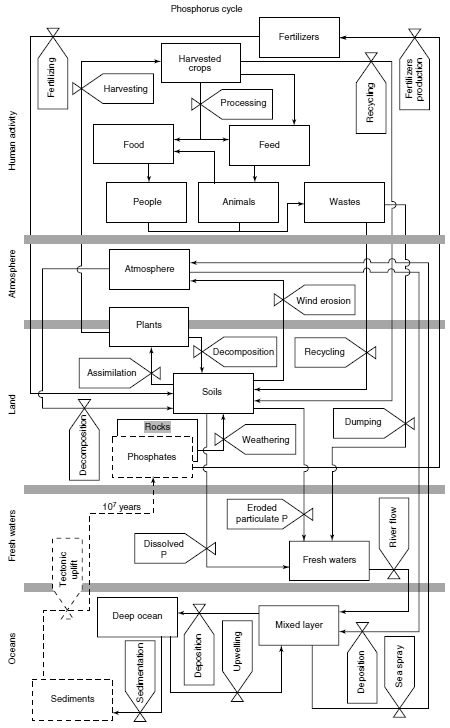
Figure 1 Global phosphorus cycle
〔Smil,V.(2002)によるPhosphorus: Global transfersから〕
『(Abstract)
Although relatively rare in the biosphere, phosphorus (P) plays
several key roles in the chemistry of life, above all due to its
presence in nucleic acids (deoxyribonucleic acid, DNA and ribonucleic
acid, RNA) and in adenosine triphosphate, the life's carrier of
energy. Phosphorus - unlike carbon, C, nitrogen, N and sulfur,
S - does not form any long-lived atmospheric compounds and hence
its global cycle is just a part of the grand, and slow, process
of denudation and geotectonic uplift. But on a small scale the
element is rapidly recycled between organic and inorganic forms
in soils and water bodies. Human activities now annually move
more than four times as much phosphorus as did the natural processes
during the preagricultural era.
Together with nitrogen and potassium, phosphorus is one of the
three macronutrients needed by all plants, and its applications
in inorganic fertilizers have been essential for raising crop
yields during the 20th century. The nutrient is also frequently
the limiting factor of aquatic productivity, and even its relatively
low concentrations present in the runoff from fertilized fields
can cause eutrophication (excessive nutritional enrichment) of
both fresh and ocean waters, an environmental change with numerous
undesirable consequences. Fortunately, appropriate agronomic practices
and wastewater treatment can moderate the environmental impact
of anthropogenic phosphorus.』
Importance of the element
Natural sores and flows of phosphorus
Anthropogenic mobilization of phosphorus
Dependence on inorganic fertilizers
Phosphorus in agricultural soils
Phosphorus in waters
Moderating the human impact
References
 Figure 1 Global phosphorus cycle 〔Smil,V.(2002)によるPhosphorus: Global transfersから〕 |
| リンのリザーバ | 全量(100万トンP) |
| 海洋 | 93000 |
| 表層 | 8000 |
| 深層 | 85000 |
| 土壌 | 40-50 |
| 無機リン | 35-40 |
| 有機リン | 5-10 |
| 植物体 | 570-625 |
| 陸上 | 500-550 |
| 海洋 | 70-75 |
| 動物体 | 30-50 |
| 人間体 | 3 |
| リンのフラックス |
年間速度 (100万トンP/年) |
| 大気沈着 | 3-4 |
| 浸食と流出 | 25-30 |
| 粒状リン | 18-22 |
| 溶存リン | 2-3 |
| 植物摂取 | 970-1300 |
| 陸上 | 70-100 |
| 海洋 | 900-1200 |
| 海洋堆積物中への埋没 | 20-35 |
| 構造的隆起 | 15-25 |
| フラックス | 天然 |
産業化以前 (1800年) |
現在 (2000年) |
| 人間活動によって増加した天然フラックス | |||
| 浸食 | >10 | >15 | >30 |
| 風 | <2 | <3 | >3 |
| 水 | >8 | >12 | >27 |
| 河川運搬 | >7 | >9 | >22 |
| 粒子状リン | >6 | >8 | >20 |
| 溶存リン | >1 | <2 | >2 |
| 生物体燃焼 | <0.1 | <0.2 | <0.3 |
| 人為源フラックス | |||
| 農作物摂取 | - | 1 | 12 |
| 動物排泄物 | - | >1 | >15 |
| 人間排泄物 | - | 0.5 | 3 |
| 有機リサイクリング | - | <0.5 | >6 |
| 無機肥料 | - | - | 15 |